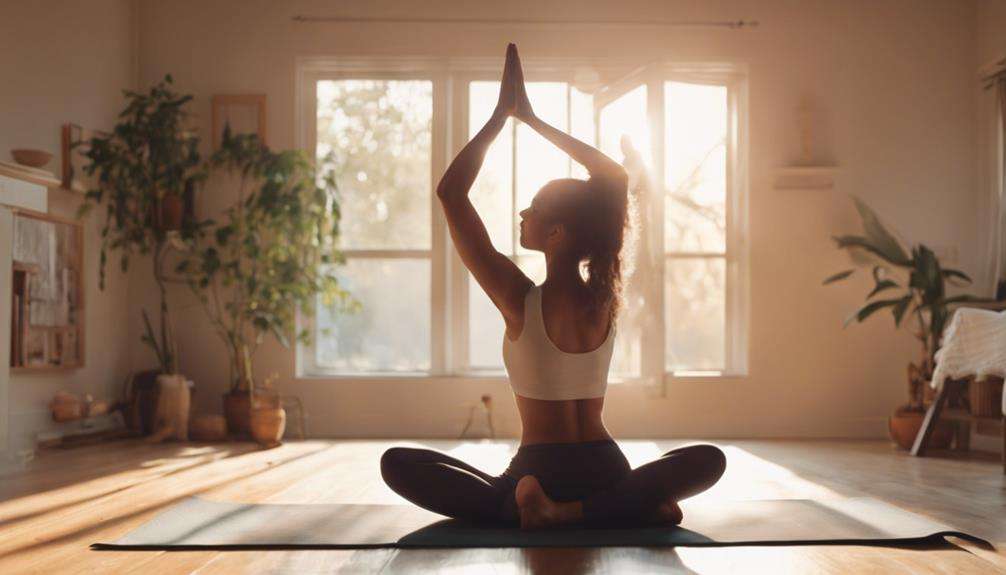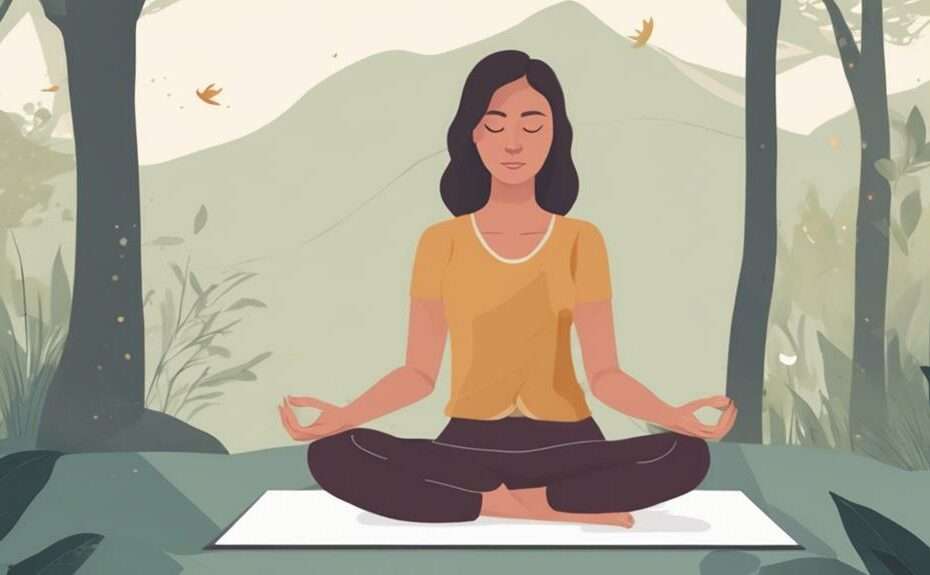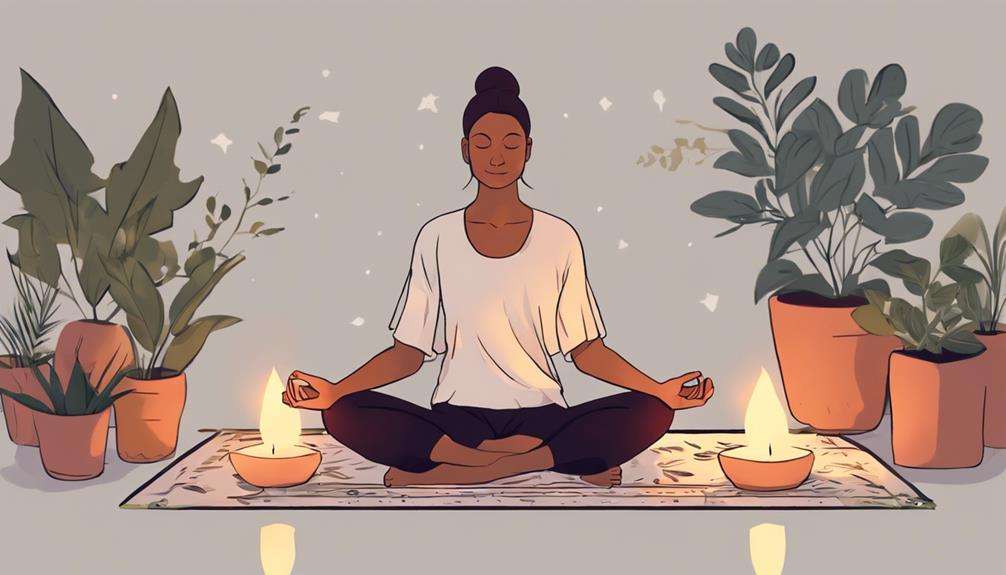You may not realize that emotional balance plays a significant role in your overall well-being.
Have you ever wondered how yoga and meditation can help you achieve this equilibrium?
By exploring the 10 best practices for emotional balance through these ancient techniques, you'll discover practical tools to navigate the complexities of your emotions and lead a more harmonious life.
Key Takeaways
- Yoga and mindfulness techniques promote emotional well-being and reduce stress effectively.
- Specific yoga poses and relaxation techniques aid in releasing emotional tension and promoting relaxation.
- Meditation practices like mindfulness and guided meditation enhance self-awareness and emotional balance.
- Holistic approaches such as chakra balancing and deep breathing techniques support emotional equilibrium and overall well-being.
Benefits of Yoga for Emotional Balance
Embrace the transformative power of yoga for cultivating emotional balance by nurturing self-awareness and inner peace. Through the practice of yoga, you can discover a profound sense of self-awareness that allows you to navigate your emotions with grace and clarity. Yoga serves as a powerful tool for stress management, offering techniques that promote relaxation and improve mental clarity. By engaging in yoga postures and breathing exercises, you can enhance your ability to regulate emotions and find inner peace amidst life's challenges.
Furthermore, yoga is renowned for its ability to promote emotional stability and mental well-being. The holistic approach of yoga not only benefits your physical health but also nurtures your emotional balance. By incorporating yoga into your daily routine, you can experience a greater sense of calmness, improved focus, and enhanced emotional resilience. The practice of yoga offers a sanctuary for relaxation and self-reflection, allowing you to cultivate a deeper connection with yourself and the world around you.
Mindfulness Practices for Emotional Wellness
To enhance your emotional wellness, incorporating mindfulness practices into your daily routine can be transformative. Mindfulness involves being fully present in the moment without judgment, leading to improved emotional well-being. By practicing mindfulness meditation, you can reduce stress, anxiety, and negative emotions by cultivating self-awareness and acceptance of your thoughts and feelings.
Deep breathing techniques within mindfulness practices can help regulate your emotions and induce a sense of relaxation, contributing to a more balanced emotional state. Engaging in mindfulness exercises such as body scans and mindful walking can heighten your awareness of your internal experiences, promoting emotional clarity and understanding.
Additionally, integrating gratitude into your mindfulness practice can shift your focus from stressors to the positive aspects of your life, fostering feelings of contentment and emotional balance. By embracing mindfulness and incorporating these practices into your daily routine, you can cultivate positive emotions and nurture your overall emotional well-being.
Yoga Poses for Stress Relief

Feeling overwhelmed by stress? Discover calming yoga sequences, relax into poses that release tension, and practice breathing techniques to ease your mind and body.
Yoga offers a sanctuary for you to find peace within the storm of stress, helping you navigate emotions with grace and resilience. Let these yoga poses be your anchors in the sea of stress, guiding you back to a place of serenity and balance.
Calming Yoga Sequences
Discover how incorporating specific yoga poses into your practice can help you find relief from stress and emotional tension. Poses like Half Pigeon, Camel, and Warrior 2 are known to release emotional tension and stress from the body.
When you practice Humble Warrior and Reclined Spinal Twist, you promote surrender, trust, and emotional cleansing. These calming sequences aid in processing heavy emotions, enhancing self-awareness, and promoting mental clarity.
Remember, modifications such as using props or adjusting foot placement can make your practice more comfortable and accessible. By incorporating these poses into your routine, you can experience improved emotional balance and overall well-being.
Start your journey towards emotional balance through these calming yoga sequences today.
Relaxing Poses for Tension
Ease your mind and body with these relaxing poses specifically designed to relieve tension and promote stress relief through gentle stretches and supported postures.
Incorporate yoga poses like Child's Pose, Legs Up the Wall, and Corpse Pose into your daily routine to release tension in areas like the back, shoulders, and hips. These poses not only alleviate stress but also calm the mind, promoting emotional balance.
Engage in gentle stretches such as Cat-Cow and Forward Fold to ease muscle tension and encourage deep breathing, further enhancing relaxation. Utilize props like bolsters and blankets for supported poses, creating a restorative experience for stress relief.
Breathing Techniques for Stress
Enhance your stress relief practice with effective breathing techniques integrated into yoga poses to promote emotional balance and well-being. Dive into these proven methods to harness the power of breath for stress relief:
- Deep belly breathing activates the relaxation response, reducing stress levels.
- Nadi Shodhana balances the nervous system and calms the mind.
- Bhramari pranayama, or the humming bee breath, soothes the nervous system with sound vibrations.
- Yoga Nidra, a guided meditation practice, induces deep relaxation for emotional well-being.
- Specific breathing techniques in yoga poses release tension, calm the mind, and restore emotional balance effectively.
Meditation Techniques for Calmness

Several meditation techniques can effectively cultivate calmness and emotional balance in your daily life.
Guided meditation can help you focus on the present moment, enhancing self-awareness and reducing stress.
Positive affirmation meditation is a powerful tool to shift your focus from stress to gratitude and positivity, promoting emotional well-being.
The 6 Phase Meditation technique incorporates gratitude, forgiveness, and visualizing goals, providing a holistic approach to emotional balance.
Mindfulness meditation is known for reducing tension and anxiety while increasing emotional stability.
Additionally, moving meditations such as yoga, qigong, and tai chi combine physical movement with mindfulness practices, offering a unique way to achieve calmness.
Breathing Exercises for Emotional Stability
Take a moment to focus on your breath and its gentle rhythm.
Deep belly breathing can help activate your body's relaxation response, fostering emotional stability.
Deep Breathing Techniques
To cultivate emotional stability and inner peace, incorporating deep breathing techniques like Diaphragmatic Breathing into your daily routine is key. These practices have a profound impact on your emotional well-being by reducing stress hormones like cortisol and increasing feel-good hormones such as endorphins.
Diaphragmatic Breathing specifically enhances oxygen flow, promoting a sense of calm and emotional stability. Box Breathing, another effective technique, involves rhythmic inhaling, holding, exhaling, and holding the breath to maintain emotional balance.
Mindful Breath Awareness
Transitioning from deep breathing techniques, such as Diaphragmatic Breathing and Box Breathing, into mindful breath awareness is a powerful journey towards emotional stability and inner peace.
Mindful breath awareness involves focusing on the inhalation and exhalation patterns, anchoring you in the present moment. This practice is a crucial component of yoga and meditation for enhancing emotional stability and mental clarity.
By observing your breath, you can cultivate self-awareness, regulate your emotions, and foster inner peace. Deep breathing exercises play a vital role in stimulating the parasympathetic nervous system, leading to relaxation and reduced stress.
Regular practice of mindful breathing techniques can significantly improve your emotional balance and overall well-being. Embrace this practice to nurture a deep sense of calm and tranquility within yourself.
Incorporating Yoga Into Daily Routine

Consider incorporating a few minutes of yoga into your daily routine to cultivate peace and focus. Starting your day with simple poses like sun salutation or cat-cow stretch can help release tension and set a positive tone for the day ahead.
Enhancing blood flow through gentle movements not only prepares your body for a productive day but also boosts your mental clarity. Taking short breaks throughout the day to practice yoga positions can significantly reduce stress levels and improve your concentration.
Setting intentions before your yoga practice allows you to stay centered and motivated, helping you navigate daily challenges with a sense of peace and purpose.
- Begin the day with yoga for peace and focus
- Practice simple poses to release tension
- Enhance blood flow for mental clarity
- Take short breaks for stress reduction
- Set intentions to stay centered throughout the day
Emotional Healing Through Meditation
If you're seeking emotional healing and inner peace, meditation offers a powerful path to self-awareness and tranquility.
Through mindfulness meditation, you can observe your emotions without judgment, fostering a deep understanding of your inner world and promoting emotional healing.
The practice of deep breathing techniques during meditation helps calm the mind, allowing you to release emotional distress and find a sense of balance.
Additionally, incorporating gratitude practices into your meditation sessions can shift your focus from negative emotions towards the positive aspects of your life, promoting a sense of emotional well-being.
For those new to meditation, guided meditation sessions can be particularly beneficial, providing gentle guidance to help you relax, unwind, and find emotional equilibrium.
Yoga Nidra for Relaxation

For those seeking deep relaxation and stress relief, Yoga Nidra offers a guided meditation technique that promotes profound calmness and emotional balance. This practice involves lying down comfortably, focusing on different parts of the body, and allowing the mind to enter a state of deep relaxation.
Here are some key points to highlight the benefits of Yoga Nidra:
- Yoga Nidra is a guided meditation technique that promotes deep relaxation and stress relief.
- It involves lying down in a comfortable position while focusing on different parts of the body.
- Yoga Nidra helps calm the nervous system, reduce anxiety, and improve sleep quality.
- The practice of Yoga Nidra can lead to heightened self-awareness and emotional balance.
- Regular practice of Yoga Nidra can enhance overall well-being and mental clarity.
Chakra Balancing With Yoga
To deepen your emotional balance and well-being, explore the practice of Chakra Balancing through yoga. This practice focuses on aligning your body's energy centers for enhanced emotional stability and clarity. Chakras, the energy centers in your body, are closely linked to emotions, behaviors, and physical health.
By incorporating specific yoga poses and meditation techniques designed to balance and align these chakras, you can experience a profound impact on your emotional state and overall wellness. Each chakra corresponds to particular emotions and aspects of life, influencing both mental and physical well-being.
When these chakras are balanced through yoga practices, they promote harmony, clarity, and emotional stability. The goal of chakra balancing in yoga is to release blockages, increase self-awareness, and cultivate inner peace. Through this process, you can develop a deeper connection with yourself, leading to improved emotional balance and a greater sense of well-being.
Maintaining Emotional Equilibrium With Meditation

When it comes to maintaining emotional balance with meditation, you can rely on mindfulness practices to ground yourself in the present moment, reducing stress and promoting well-being.
Engaging in deep breathing techniques during meditation sessions can help regulate your heart rate, inducing a sense of relaxation essential for emotional equilibrium.
Additionally, visualization practices in guided meditation sessions offer a structured approach to enhance emotional stability, supporting you in achieving a harmonious state of mind.
Mindfulness for Emotional Balance
By incorporating mindfulness meditation into your daily routine, you can cultivate emotional balance and enhance your overall well-being. Mindfulness practices like deep breathing and body scans help you observe your thoughts and emotions objectively, fostering self-awareness and reducing reactivity.
The 4-7-8 breathing technique, when integrated into mindfulness meditation, can effectively calm your mind and body, promoting emotional equilibrium. Regular mindfulness practice can lead to reduced tension, anxiety, and stress levels, ultimately providing clarity, peace, and resilience for your emotional well-being.
- Mindfulness meditation helps you observe thoughts and emotions objectively.
- Deep breathing and body scans reduce tension, anxiety, and stress.
- The 4-7-8 breathing technique calms the mind and body.
- Mindfulness fosters self-awareness and reduces reactivity.
- Regular practice enhances emotional well-being.
Breathing Techniques for Equilibrium
Deep belly breathing techniques, such as diaphragmatic breathing, play a vital role in regulating emotions and reducing stress levels to maintain emotional equilibrium during meditation.
By focusing on your breath, you can cultivate mindfulness and enhance self-awareness, leading to a more balanced emotional state. Mindful breathing practices like Nadi Shodhana and Bhramari pranayama can help bring clarity to your mind and promote emotional stability.
Yogic breathing techniques such as Kapalabhati serve to invigorate your body and mind, aiding in achieving emotional equilibrium. Integrating meditation with breathwork offers a powerful tool for reducing anxiety and fostering inner peace, ultimately supporting your journey towards emotional balance.
Visualization Practices for Stability
To deepen your emotional balance through meditation, incorporating visualization practices can be a powerful tool for fostering stability and inner peace. Visualization practices involve creating mental images to promote emotional stability and balance. By focusing on positive and calming scenarios, you can reduce stress and anxiety. Visualizing serene environments like a peaceful beach or a lush forest can evoke feelings of relaxation and tranquility. Engaging in visualization techniques helps you manage emotions and cultivate inner peace effectively. Regular practice of visualization in meditation contributes to a heightened sense of emotional equilibrium and overall well-being.
- Create mental images for emotional stability
- Focus on positive scenarios to reduce stress
- Visualize peaceful environments for relaxation
- Enhance emotional management through visualization
- Regular practice leads to emotional equilibrium and well-being
Frequently Asked Questions
How Do You Release Trapped Emotions With Yoga?
To release trapped emotions with yoga, focus on breathwork techniques, heart opening poses, mindfulness meditation, grounding exercises, self-awareness practices, and relaxation techniques. Engage in these practices consistently to create space for emotions to surface and be released.
Which of the Following Yoga Practices Help in Emotional Management?
When practicing yoga for emotional management, focus on breath awareness, mind-body connection, chakra balancing, self-reflection, emotional release, and stress reduction. These practices are like a soothing balm for your soul, bringing peace and balance.
Which Yoga Is Best for Emotional Management?
For emotional management, Kundalini Yoga enhances well-being with breathwork, chanting, and meditation. Restorative Yoga promotes deep relaxation. Yin Yoga stretches and releases tension. Hatha Yoga combines movement and breath for stability. Choosing the right practice benefits your emotional balance.
How Do You Practice Emotional Balance?
To practice emotional balance, start with mindful breathing. Engage in grounding exercises, use visualization techniques, self-reflect, tune into body awareness, and regulate emotions. These practices help you cultivate inner peace and enhance emotional well-being.
Conclusion
As you journey towards emotional balance through yoga and meditation, remember that just like a tree sways in the wind but remains rooted in the ground, you too can navigate life's storms while staying grounded in your inner peace.
Embrace these practices as tools to weather any emotional turmoil, cultivate resilience, and find harmony within yourself. Allow yourself to grow stronger and more balanced, just like the tree that bends but never breaks.
You've got this.






